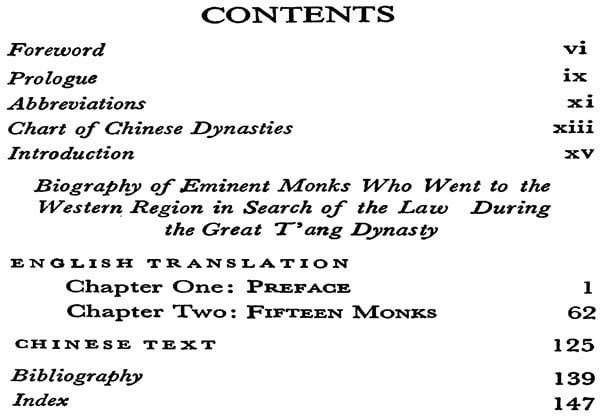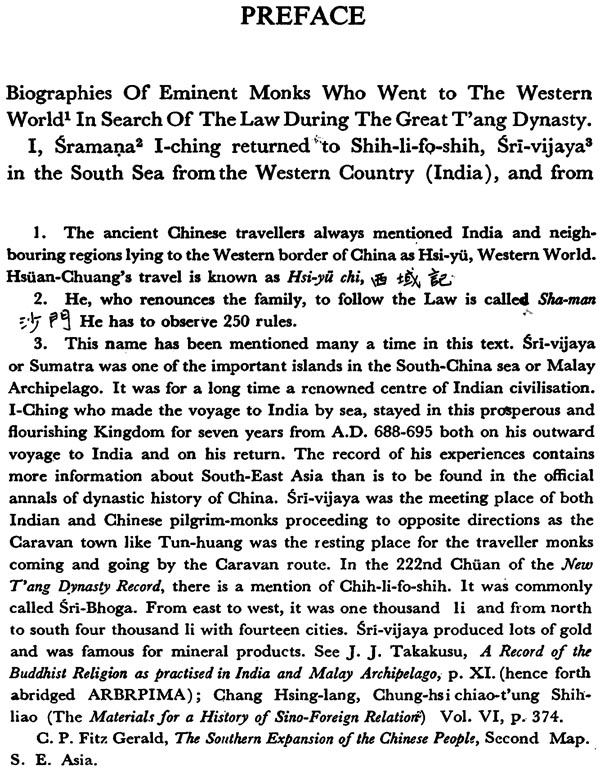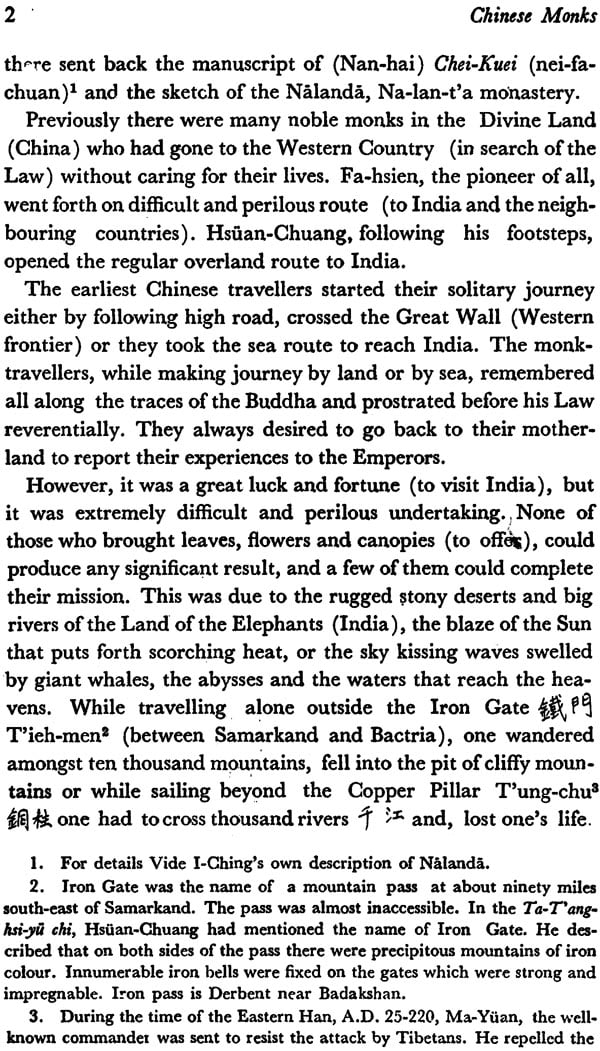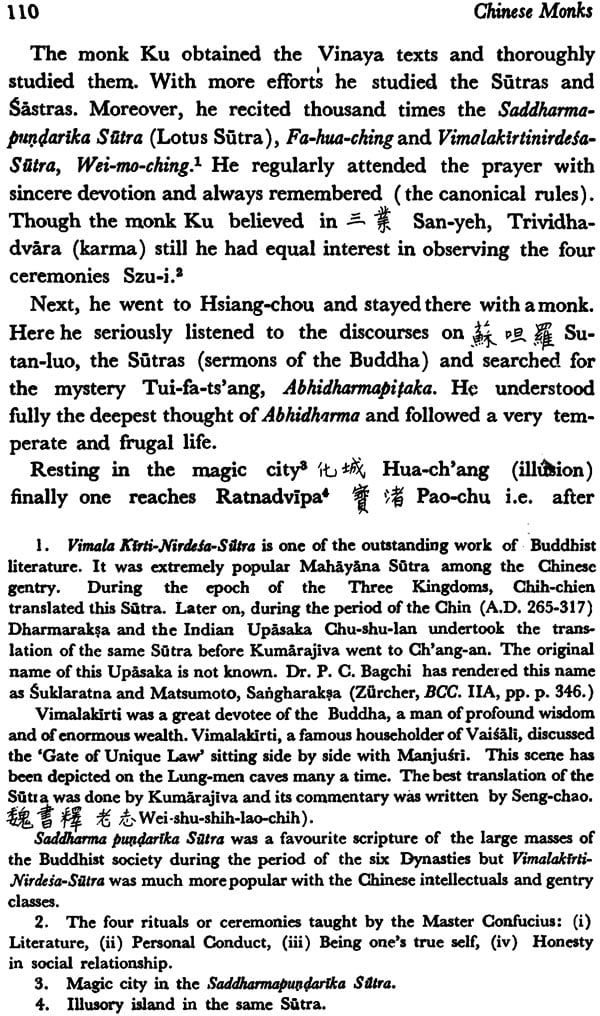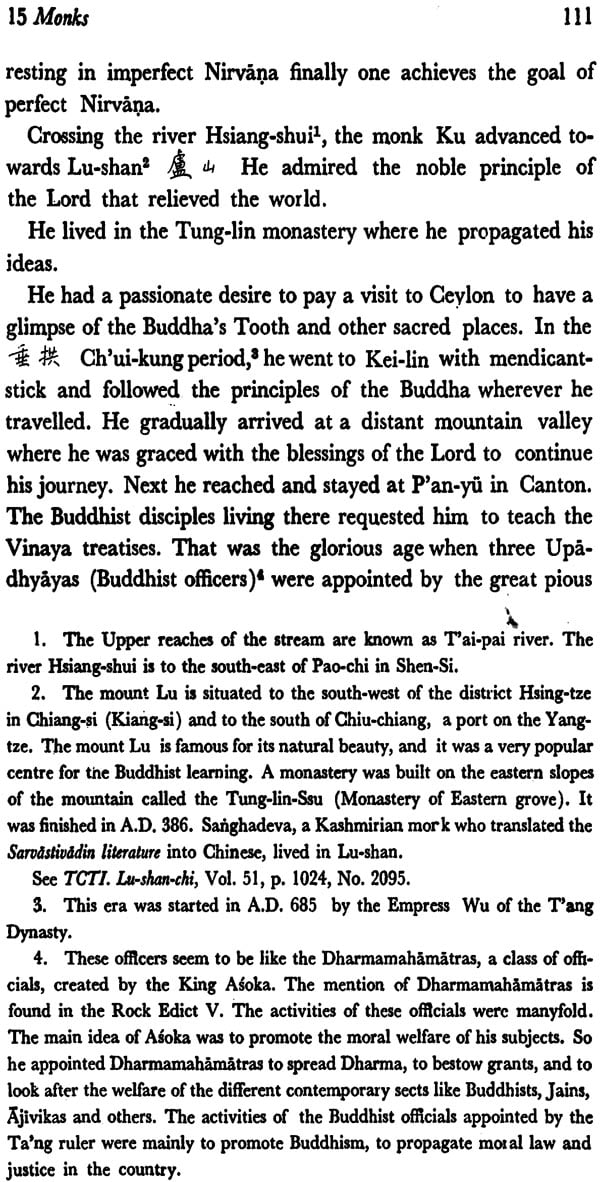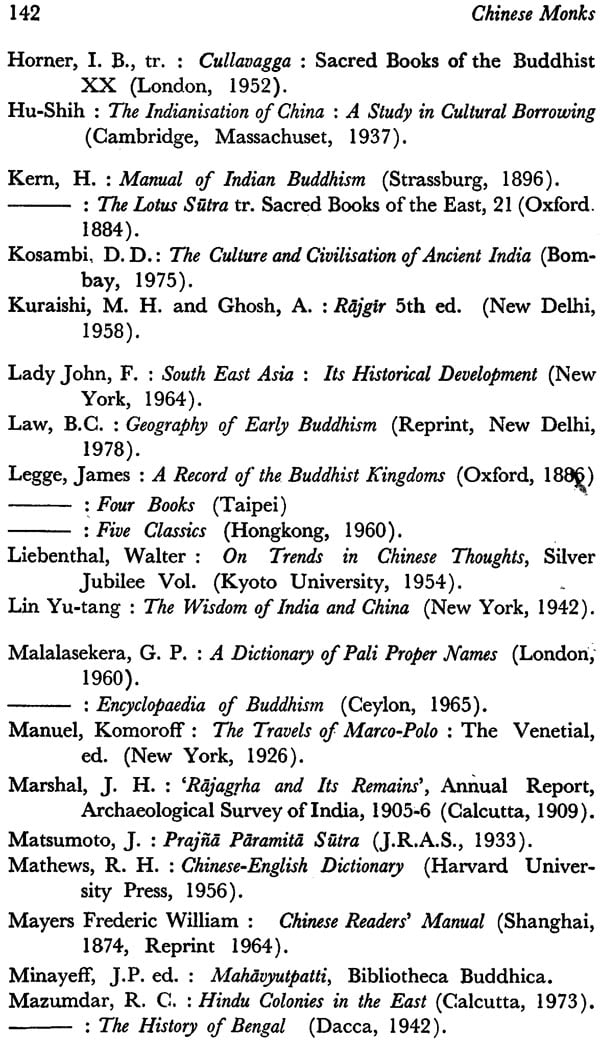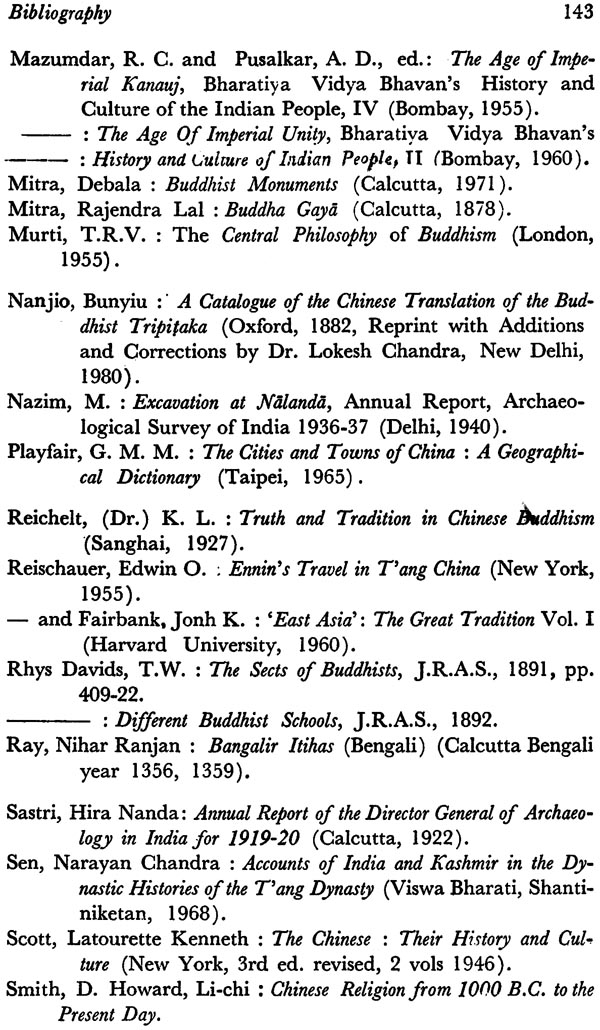
Chinese Monks in India
Book Specification
| Item Code: | NAT916 |
| Author: | Latika Lahiri |
| Publisher: | MOTILAL BANARSIDASS PUBLISHERS PVT. LTD. |
| Language: | ENGLISH |
| Edition: | 2015 |
| ISBN: | 9788120800625 |
| Pages: | 179 |
| Cover: | HARDCOVER |
| Other Details | 9.00 X 6.00 inch |
| Weight | 360 gm |
Book Description
The Sino-Indian cultural relation began through Buddhism. It was a common ground for intellectual and spiritual interest and intercourse between India and China.
The present work is a translation of a seventh-century text Kao-Seng-Chuan (Biographies of Eminent Monks) by the renowned Chinese monk-scholar I-ching (A.D. 614-713). It consists of biographies of fifty-six monks. Among the Chinese pilgrim-monk-scholars who visited India, Fa-hsien, Hsuan-chuang and I-ching are best known for having played the greatest role in the history of Sino-Indian cultural relation. However, the fifty-six monks whose adventurous travels and experiences are recorded in this book are no less important as active promoters of the most cordial relations between the two great countries.
Most of these fifty-six monks from China visited India on pilgrimage and for collection of texts to enrich Buddhist literature in their own homeland. In this book I-thing has also given a vivid, though not full-length, description of the premier University of Nalanda, the seat of Buddhist learning. The academic life and activities of Nalanda attracted the Chinese monks in a large number for higher studies.
Written with insight, realism and clarity, I-ching's book is thought-provoking. All these features are carefully preserved in this translation which will no doubt evoke interest among scholars as well as general readers.
LATIEA LAHIRI, the translator of I-ching's work (Kao-Seng-Chuan), was born in 1923 in undivided Bengal. She obtained her M.A. Degree in Ancient Indian History and Culture from the University of Calcutta. She had the opportunity to study under Dr. P.C. Bagchi, one of the great exponents of Sino-Indian cultural relations.
Miss Lahiri was in China in 1956-59 on Government of India's scholarship to study Chinese language (modern and classical) and history of Buddhism in Beijing University. There she started working on the present work under the able guidance of Dr. J. Xien Lin, the well-known Indologist and the Director of the Beijing University. She also studied the Lungmen Caves under Professor Feng, retired Professor of Indian Philosophy, Tokyo University.
Miss Lahiri has published a number of papers and articles on Lungmen Caves in various well-known academic journals. She has translated and published the Grottoes of Mai-chi Mountain (the Life of Dr. Dwarakanath Kotnis) written by Mr. Gao Liang.
The Kao seng-chuan, "Biographies of Eminent Monks", writ-ten in the third half of the seventh century, by the famous monk-scholar, I-thing, is the prototype of earlier Buddhist compilations. I-ching's Kao seng-chuan is undoubtedly an indispensable source of and an outstanding work dealing with the history of Buddhism and Buddhist Church in China, and the socio-political and cultural history of India of the seventh and eighth centuries. It is a brilliant piece of literature of the T'ang period (A.D. 618-907). I-ching's poetic expression at the end of major and minor biographies and his style sometimes excel even the famous writers and secular poets of that period.
The compilation of lives of eminent monks is not 'an innovation by I-ching. From the very hoary ancient days, the Chinese had shown their eagerness and keen insight to preserve their history.
Their love for history and interest in historical records encouraged the Buddhist scholars of China to preserve the valuable biographies of devoted, intrepid, illustrious and worthy monks from India and Central Asia. Their lives are included in Kao seng-chuan. I-ching only followed the tradition and time honoured convention, methodology, and more or less the same style as adopted by his predecessors like Hui-chiao , Seng-yh .(it 42 and others. The Kao seng-chuan (Chinese Tripitaka, Taisho Ed. Vol. 50, No. 2059 in 14 chapters) of Hui-chiao (A.D. 497-554) contains 257 major and 259 minor biographies of eminent monks, from A.D. 67 to 519, thus covering almost five hundred years. The monk Seng-yu (who lived under the reign of the Emperor Wu of the Liang Dy.-A.D. 502-557), in the last three chapters of Collection of notes concerning the translation of Tripitaka (T. 2145), gives biographies of 32 famous monks, mainly translators and exegetes.
Tao-hsuan, the most famous Buddhist historian of the T'ang Dynasty (A.D. 618-907), continued the series of eminent monks known as Hsu-kao seng-chuan, Further Biographies of Eminent Monks, which contains biographies of 33 monks (CTT 50 No. 2060, pp. 425, 657 c-658a ). Not only the biographies of eminent monks have been preserved but also lives of eminent nuns have occupied the same exalted position in the Kao seng-chuan (here-after abbreviated KSC ). It records the biographies of 65 Eminent Nuns, Pi-ch'iu-ni chuan (CTT 2065) compiled by Pao-ch'ang of the Liang Dynasty. All these intellectual elites' writings of lives of eminent monks, on account of their excellent qualities, both as historical as well as literary works, became the standard to be followed by future biographers. I-ching tried to write within the convention and tradition of Chinese historiographers. The historical biographies of the renowned Indian Acaryas like Agvaghosal, Nagarjuna2, Arya-deva3, and Vasubandhu4 and the biography of Emperor Moka5 and others are to be found in KSC. These biographies are undoubtedly an indispensable source for the history of the early gentry Buddhism and Buddhist Church in China and are of immense importance for their literary and social value.
The monk Hui-min # tic, of the Liang Dynasty (A.D. 502-557), first introduced the title KSC and gave the name to his work. Hui-chiao, compiler of KSC wrote in his preface "...If men of real achievement conceal their brilliance then they are eminent but not famous; when men of slight virtue happen to be in accord with their times then they are famous but not eminent." Thus Hui-chiao has made a clear-cut distinction between an eminent monk and a famous one. A famous monk might be able to glorify his religion during his life time but an eminent monk was able to set open a new vista and was to herald a new epoch is Buddhism by his brilliant scholarship and example, and his life would be the model to future generations. I-ching undertook the difficult task of collecting and compiling the biographies of fifty-six monks who may not be considered as important as Tao-an, Hui-chiao, Kumarajiva and others but their contribution is equally great in promoting and transmit-ting the light of Buddhism. From his preface, from his KSC as well as from his own biography, we understand his various motives which prompted the writer in compiling the biographies of eminent monks.
His main objective was to immortalise those self-sacrificing monks who made a striking contribution to the propagation and prosperity of Dharma bequeathed by the Buddha. They were the torch-bearers who would illuminate the posterity. I-ching not only tried to establish the religious eminence of the monks but also the prestige and honour they commanded from the people, officials, kings, princes in China as well as in India. The austere lives, self-sacrificing and adventurous spirit, the brilliant scholarship and wonderful accomplishment of the Buddhist monks would inspire the future generations. In this regard I-ching's monks are eminent.
**Contents and Sample Pages**
